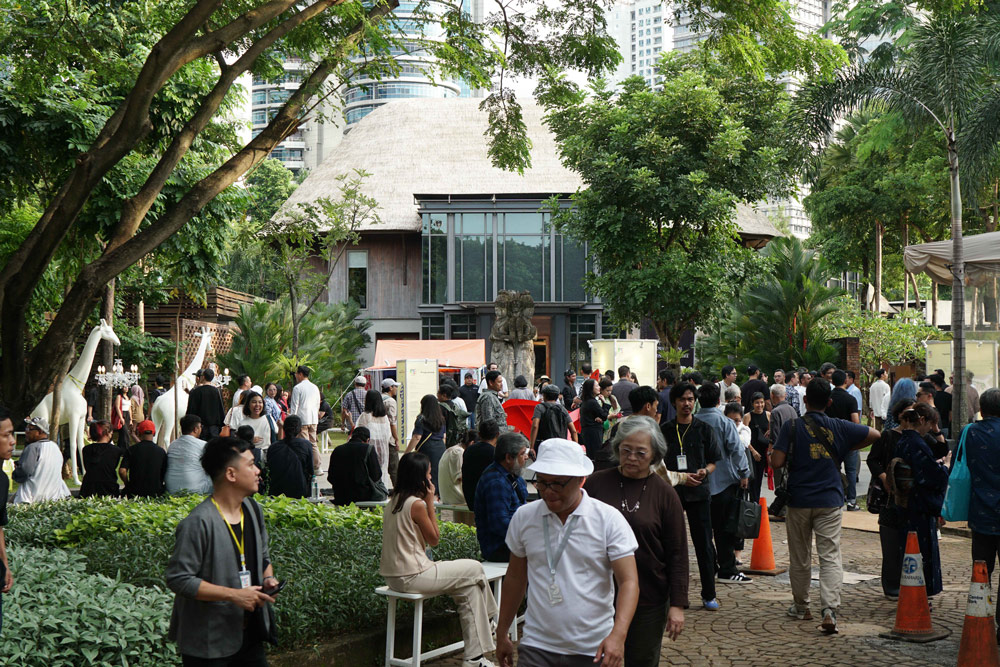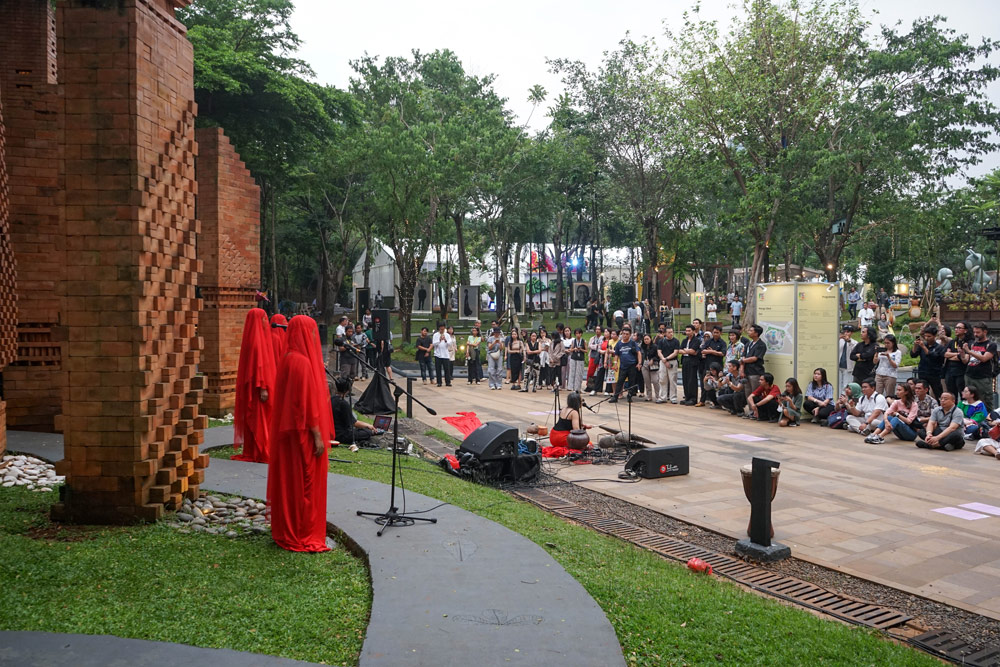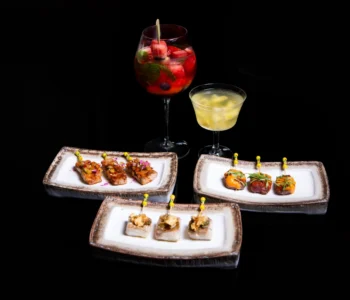Art Jakarta Gardens, held 23-28 April 2024 amidst the lush greenery at Hutan Kota by Plataran in Semanggi, Jakarta, is a new model of art fair devised in 2022 as a response to the pandemic introducing an exciting and unique format to Southeast Asian art.

Art Jakarta Gardens balanced two components. It showcased twenty-three local and international galleries set within two air-conditioned pavilions presenting two- and three-dimensional modern and contemporary Indonesian and foreign art. Thirty sculptures and installations distinguished the Sculpture Garden, sited within tropical grounds and the iconic architecture of Hutan Kota by Plataran. Art and musical performances perfectly activated the sultry outdoor atmosphere, merging the landscape with individual and collective creative expression.
Art fairs allow connoisseurs and new collectors, art lovers, and the curious to engage with a broad range of two and three-dimensional artworks all within one area, granting a snapshot into the current status of an art scene. Social interaction grants opportunities to consolidate and make new meaningful connections. The ideal art fair experience invigorates the exchange of ideas. Presenting contemporary art via new models such as Art Jakarta Gardens, introduces the possibility of unconventional happenings, especially how people may learn to live with and enjoy art, and how art in open-air environments can enhance living and working situations and lifestyles. Emphasising sculptural works within nature creates a unique dialogue between the works and their surroundings.

“The new art fair concept is our response to COVID and its dramatic impact on the art world. The Art Jakarta team envisioned a scenario of people engaging with art in a beautiful outdoor setting enhanced by nature,” Art Jakarta Gardens Fair Director Tom Tandio said. “We wish to enhance the fair experience with indoor and outdoor presentations. 3D works are especially complementary when positioned in the environment.” “We hope Art Jakarta Gardens can contribute to the opportunity for young people to learn and be more appreciative of art. In Art Jakarta Gardens, the young generation can get to know art in less formal surroundings and even start collecting,” Tom said. “We also encourage more corporations to collaborate with Indonesian artists, whether in Art Jakarta Gardens or other projects, and hope that it will add to stronger support for the art ecosystem.”
Art Jakarta Gardens featured well-known gallery brands Gajah, ROH Projects, Nadi, RUCI, CAN’s, ISA, ArtSociates, SriSasanti and Jagad, whose booths reflected a diverse array of some of the region’s finest talents. Art Agenda presented ‘Healing’, a showcase of 40-plus works by emerging Indonesian artists interpreting the theme of healing. While many galleries presented trend-driven commercial prospects, Art Agenda positioned art’s enduring functional values in the spotlight distinguishing their brand. A+ Works of Art Kuala Lumpur showcased SE Asian artists. Especially compelling were the vibrant miniatures by Afghan-born, Yogyakarta-based Amin Taasha, who delivers WOW within the small format, a feat few painters can achieve. Ruth Marbun’s quirky, small, figurative abstracts are worth noting too. Awangart’s pulsating geometric fractal paintings are out of this world. The influence of 3D works inspired by toys is a growing phenomenon in global art. It offers new and unusual entry points for people wishing to begin building a collection or making one-off or unusual purchases. This genre was prominent within the fair’s indoor and outdoor presentations.

“This is a satisfying first experience for Zen 1. It’s amazing to see visitors and buyers appreciate art in such an ambience. The unpredictable weather wasn’t an obstacle; people remained enthusiastic, and everything was thoroughly well-managed. We’re proud to be part of Art Jakarta Gardens,” said gallerist Nico F.K. director of Zen 1 on exhibiting at the fair. Art Jakarta Gardens welcomed 11,899 visitors in 2024, a 10% increase from its previous edition. Artists and galleries reported strong sales throughout the event. The Sculpture Garden exhibited works from outstanding artists across generations, ranging from the Indonesian modern master G. Sidharta, the famed Nyoman Nuarta, to experimental emerging artists such as Dian Hardiansyah. Striking was ‘Red Hibiscus’ by renowned, Bali-based sculptor Pintor Sirait, responsible for many large-scale works including, ‘Flow’ his monumental public artwork in International Terminal Three at Jakarta’s Soekarno-Hatta airport.


“A blooming red hibiscus symbolises the power of love in nature. It speaks of how the lines, shape, and colour create what it symbolises; soft lines give endless, gentle movement as we examine the work,” Sirait told NOW! Jakarta Magazine. “An outdoor exhibition is always fun because we can see how the art interacts with nature or in a garden. This type of fair will open up possibilities and discussion of public art. As an artist, I feel much happier if as many people see the artwork as possible because it serves as an object which inspires, hopefully generates interesting thoughts as well as beautifies its surroundings.” “Recent government projects have included artworks in many of their outdoor and indoor spaces. I think the private sector can also make beautiful outdoor spaces and bring excellent works out to the public from the artist’s studio,” Sirait said. “It will create a sense of competition of excellence, which is healthy for the growth of our understanding of how art can serve.”
Art Jakarta Gardens Public Programs included guided tours of the fair, talks, music and performances. The RURUradio Lounge provided entertainment with selections of music live-streamed throughout the venue and offering interesting discussions by artists and creatives. Live performances featured White Shoes and The Couples Company, LAIR, Rani Jambak, and Keroncong Musyawarah. Showstopping! Monica Hapsari and friends’ potent 30-minute ode to the ancestors PITARAH was a supersonic, ultra-hypnotic music, dance and voice exploration. Accompanied by four vocalist-performers, musicians and a sound engineer, Monica drew upon past cultural practices to unite the living with the spirit of the dead. This shamanic journey fused West Javanese ritual with contemporary expression. Powerfully introspective, enthralling and emotionally confronting, PITARAH elevated onlookers into celestial realms while creating an interlude of menacing skies.

Indonesian modern and contemporary art offers enormous cultural capital for national and foreign audiences. Large-scale platforms to present this art, costly, time-consuming, and challenging to organise, are essential to share this value with the growing local and international markets while attracting the evolving 21st-century global sphere of stakeholders. The Indonesian art market is the largest in Southeast Asia, constantly developing while attracting greater international attention. This burgeoning market demands innovative approaches to help maintain the sustainability of the art ecosystem. Art Jakarta Gardens is a breath of fresh air upon the national stage.






